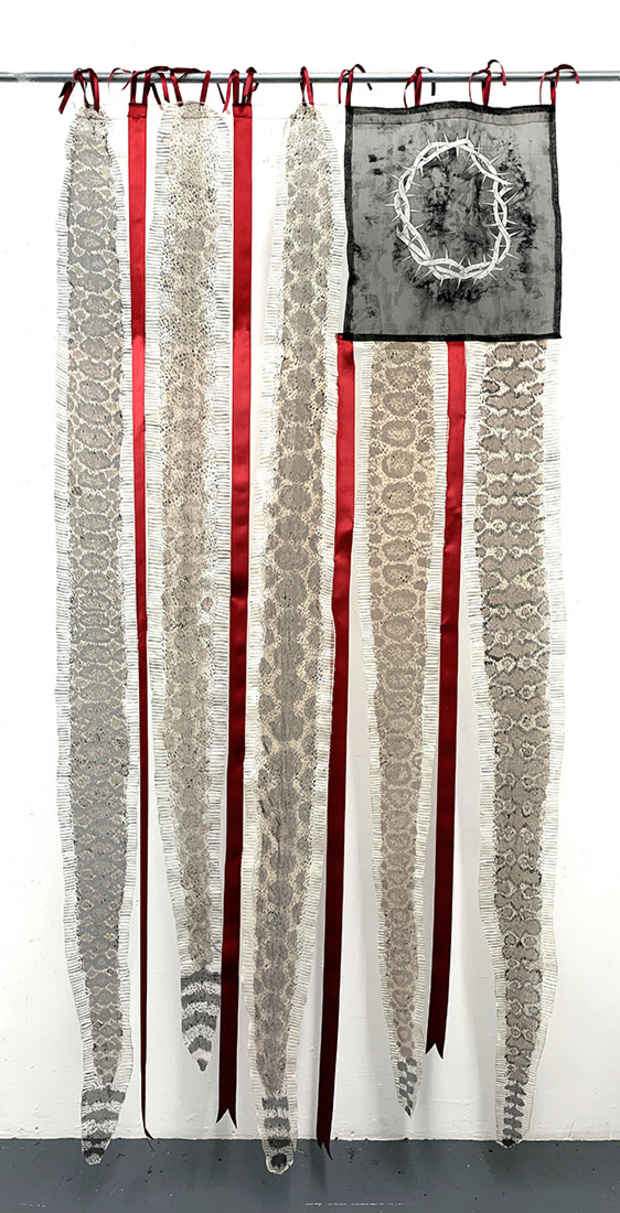“Revisions” Exhibition
Transmitter

[Image: Alexandra Hammond "Belly Sleeper" (2021) ink on silk, 39 x 83 in.]
This event has ended.
Transmitter presents Revisions, featuring works by Kalyn Fay Barnoski, Alexandra Hammond, Alicia Smith, and Jean-Marc Superville Sovak.
Historical narratives, both personal and cultural, frame how we understand ourselves and how we situate our identities within larger community frameworks. But as we are only increasingly reminded, our flawed national history is problematically narrow and myopic. In order to address and restore a more thoughtful and authentic account of our Nation’s—and our own individual—narrative we need to re-work the stories we include: any restoration requires a re-story-ation.
The exhibiting artists help broaden and redefine our understanding of cultural history by challenging the hierarchical narratives reinforced through institutional and governmental promulgation. These artists incorporate deep research—relating to their personal histories, community histories, and/or regional histories—to re-present and re-contextualize the way we understand our relationship to this land, this Nation, and our own chosen communities.
With a more honest and expansive reinterpretation of symbols and historical imagery, these artists use their research not to distribute an artifact from the past, but rather to offer a touchstone to reflect upon as we move into the future.
Kalyn Fay Barnoski’s studio practice is overarchingly defined by her ingrained Cherokee epistemologies. Her most recent pieces incorporate weaving paper and fabric into compositions suggestive of Indigenous regalia. The materials used are covered with their own histories of conversations Barnoski has had with friends and other Indigenous community members. The texts highlight the dynamics at play between recorded histories versus first-person narratives, as well as the literal and figurative overlap between contemporary culture and Indigenous culture. The woven compositions additionally underscore the tension between the personal versus the institutional when addressing the historical symbols of traditional Indigenous regalia.
Alexandra Hammond’s Rattlesnake Flags are flags for an a-heroic community as opposed to an heroic nation. They are delicate and full of holes, ecological mementos, and shadows of “old glory.” While the two flags are inspired by different memories, they are addressing different takes on a well-known symbol, one associated with the Americas and specifically with the Gadsden Flag (a historic yellow American flag with rattlesnake ready to strike and words “do not tread on me”). As part of an ongoing participatory performance project, Boa’s Repair Shop, Hammond will debut a new iteration entitled, Flag Repair: Rebuilding Relationship with Symbolic Self and Community at the gallery on November 14. Participants will be invited to rethink the symbol of the Flag—culturally, historically, visually—and what it would look like to produce a version that represents their own knowledge, identity, and experiences in a format laden with symbolism.
Alicia Smith’s videos Hueatoyatzintli and Erendina offer more fully-representative histories of land, and prompt a redefinition of our historical assumptions around a region’s maps, borders, and its people. Writing about the video Hueatoyatzintli, Smith explains: “This project began by exploring alternative histories of land, in this case specifically the Rio Grande river, and creating a map that doesn’t define borders but rather restores memories of a place. 109 people died last year crossing the river, many were descendants of those who thousands of years ago crossed heading South into Mexico. Last year a photograph went viral of Oscar Alberto Martinez Ramirez and his daughter Valeria’s bodies on the banks of the river after they tragically drowned; I wanted to create something that focused on that tragic time and grief. For that piece I wrote a poem and had it translated into Nahuatl, which is what you hear me singing in the video.”
Jean-Marc Superville Sovak’s a-Historical Landscapes are created from 19th Century landscape engravings typical of the representational idealism of the Hudson River School, but are altered to include images of captured fugitive slaves and Underground Railroad caravans. Sovak explains, “As an artist of mixed-race working in the Hudson Valley, my aim is for a-Historical Landscapes to be a decolonizing strategy to interrogate art historical conventions and to serve as a corrective by filling the absences left by those dominant narratives.”
Media
Schedule
from October 30, 2021 to December 05, 2021